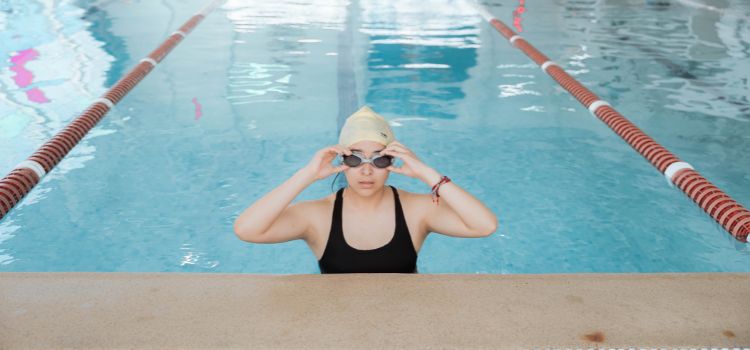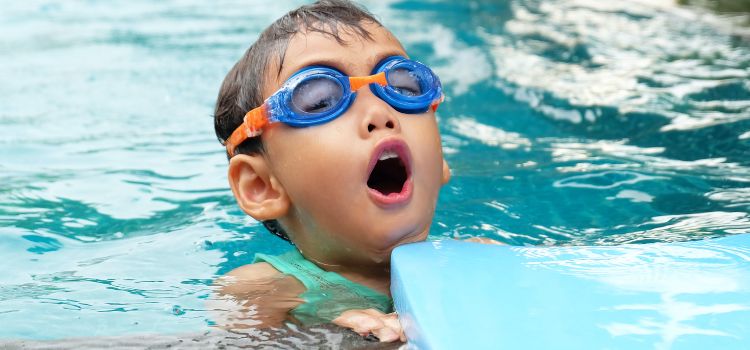As an Amazon Associate I earn from qualifying purchases.
Swimming is a popular sport and respite activity for millions of people worldwide. Whether you swim for fun, sport, or fitness is important to maintain your eyesight. A common question among contact lens wearers is whether it’s okay to swim with your contacts in while sporting goggles. This is a common topic, and the answer changes based on several factors, including the type of contacts you use, the quality of your goggles, and the water conditions. In this extensive book, we will pursue the topic of swimming with contacts and provide tips, recommendations, and sagacity to help you maintain your eye health while having fun in the water.

Swimming with Contact Lenses: Is it Safe?
The safety of swimming with contact lenses is a matter of debate among eye care professionals and users. While some people regularly swim with contact without problems, others strongly advise against it due to the potential risks involved. Let’s explore both sides of the argument.
Pros of Swimming with Contact Lenses
- Clear Vision: A primary benefit of swimming with contact lenses is the ability to see clearly underwater. When you’re in the water without vision correction, everything can look blurry, making it difficult to navigate and enjoy your time at the pool or beach. Contact lenses provide a clear, uninterrupted view of your surroundings.
- Convenience: For daily contact lens wearers, swimming without contacts might not be an option. It can be inconvenient to take out and store your contacts before swimming, particularly if you intend to jump in and out of the water several times.
- UV Protection: When swimming outside, it can be helpful to use contact lenses that provide UV protection. Your eyes are better shielded from the damaging effects of the sun thanks to this extra layer of UV protection.
- Lower Chance of Glass Loss: If you wear glasses and go swimming without contacts, there’s a chance you could drop and lose your glasses in the water. This can be a costly and inconvenient mishap that swimming with contact lenses can help you avoid.
Cons of Swimming with Contact Lenses
- Risk of Infection: Perhaps the most significant concern associated with swimming with contact lenses is the increased risk of eye infections. Water, whether in pools, lakes, or the ocean, can retain various microorganisms, including bacteria, viruses, and fungi. When water enters your eyes while wearing contact lenses, it can trap these microorganisms in opposition to the surface of the eye, possibly leading to eye infections, such as bacterial keratitis.
- Chemical Irritants: To pluck up bacteria and other impurities, chlorine is added to swimming pools. While this chemical is essential for pool sanitation, it can be irritating to the eyes. Chlorine can interact with the contact lens material and solutions, causing discomfort and dryness. Saltwater in the ocean or even freshwater in natural bodies can also have their own irritants and contaminants.
- Lens damage: The force of water, especially during activities like diving and water slides, can dislodge contact lenses from your eyes. Losing a lens in water can be frustrating, and it may not be easy to find or retrieve.
- Eye dryness: Contact lenses can absorb water and become dehydrated, causing discomfort and dryness. In a pool or a chlorinated environment, this can be exacerbated, making it uncomfortable to keep your lenses in during and after swimming.
- Corneal abrasion: When swimming, particularly in natural waters, the water may brush against the surface of your eyes. These are excruciating scratches on the cornea, and wearing contact lenses increases your risk of getting them.
- Exposure to other contaminants: Sand, dirt, and algae are just a few of the other toxins that water can bring into your eyes in addition to bacteria and chemicals. These foreign particles can be trapped under the contact lens and cause discomfort or injury.
Types of Contact Lenses
Before we delve deeper into the risks and precautions associated with swimming with contacts, let’s first understand the different types of contact lenses available. This knowledge will be crucial in making an informed decision about swimming with contacts.
There are two primary categories of contact lenses:
Soft Contact Lenses:
Soft lenses are made from hydrogel or silicone hydrogel material. They are known for their comfort and flexibility. Soft lenses can be daily disposables, bi-weekly disposables, or monthly disposables. They are a popular choice for people who wear contact lenses for extended periods.
Rigid Gas Permeable (RGP) Contact Lenses:
RGP lenses, also known as hard or gas permeable lenses are made from durable and rigid materials. They are typically used for correcting more complex vision problems, and they allow more oxygen to reach the cornea. They are less common than soft lenses but offer advantages in certain cases.
The type of contact lens you wear can influence your decision to swim with them. Soft lenses are more commonly worn and may be more comfortable for daily activities but can be more susceptible to water damage and contamination. RGP lenses may offer better resistance to water, but they come with their own set of considerations, including potential discomfort during prolonged wear.
Tips for Swimming with Contact Lenses
Swimming with contact lenses can be a convenient way to maintain clear vision in the water, but it’s important to follow safety precautions. To ensure a safer experience, consider these tips:

Swimming with Soft Contact Lenses
If you prefer to swim with soft contact lenses, it’s crucial to take extra precautions to protect your eyes. Here are some tips for safely swimming with soft contact lenses:
- Use Good-fitting goggles: Invest in a pair of swimming goggles that make a tight seal around your eyes. Properly fitted goggles help to block water from coming into contact with your lenses.
- Limit Exposure: Minimize the time you spend in the water while wearing your contacts. Extended exposure can lead to discomfort and potential damage to your lenses.
- Avoid Wearing Daily Disposables: If you wear daily disposable lenses, it’s generally not recommended to swim with them. The risk of contamination and loss is higher, and the lenses are not designed for extended water exposure.
- Consider Disposable Lenses: If you’re set on swimming with soft contacts, consider using two-week or monthly disposable lenses. They are designed for longer wear and may better withstand brief exposure to water.
- Clean Hands and Lenses: Always ensure your hands are clean and dry before handling your contact lenses. This is essential for preventing contamination while inserting or removing your lenses before and after swimming.
- Replace Lenses if Irritated: If your eyes become irritated or uncomfortable while swimming, remove your contacts immediately. Rinse them with contact lens solution and insert them back into your eyes. If the irritation persists, it’s best to discontinue swimming with contacts.
- Follow Proper Lens Care: After swimming, clean and disinfect your lenses as per your eye care professional’s instructions. This helps remove any potential contaminants and keeps your lenses in good condition.
- Carry Spares: If you are swimming away from home, consider carrying spare contact lenses, a lens case, and contact lens solution with you. In case you lose or damage a lens, you can replace it immediately.
Swimming with Rigid Gas Permeable (RGP) Contact Lenses
RGP contact lenses, being more rigid and durable, can be a better option for those who want to swim with contacts. Here are some considerations and tips for swimming with RGP lenses:
- Use Goggles: Just like with soft lenses, wearing well-fitted goggles is essential. RGP lenses are less likely to float in water, but goggles help protect your eyes from waterborne contamination and reduce the risk of debris falling under the lens.
- Regular wearers: RGP lenses can be a good choice for regular swimmers as they are water resistant. However, be mindful of potential discomfort during extended wear, especially if your eyes tend to get dry.
- Clean Lenses Properly: After swimming, clean your RGP lenses thoroughly with the recommended cleaning solution to remove any contaminants and disinfect the lenses.
- Consult Your Eye Care Professional: If you plan to swim with RGP lenses regularly, it’s a good idea to consult your eye care professional. They can recommend the best lens care routine and may adjust the fit of your lenses to enhance comfort.
Special Considerations for Swimming Environments
The choice to swim with contact lenses also depends on the type of swimming environment. Here are some specific considerations for different swimming settings:

- Swimming Pools: Chlorinated water in swimming pools can cause discomfort and may lead to eye irritation when wearing contact lenses. Using goggles and following the above precautions is especially important in this setting.
- Saltwater Swimming: Swimming in the ocean or saltwater pools can be more comfortable for some contact lens wearers, as the saltwater may not irritate the eyes as much as chlorinated water. However, saltwater can still pose risks, so wearing goggles is recommended.
- Freshwater Swimming: Lakes, rivers, and other freshwater bodies may contain microorganisms that can pose a greater risk of eye infections. Properly fitting goggles are essential in such environments.
- Open Water Swimming: For those participating in open water swimming or water sports, the risks are heightened. The water quality is variable, and debris can be abundant. Wearing contact lenses during these activities should be approached with caution, and goggles are a must.
Alternatives to Swimming with Contacts
If you’re concerned about the risks associated with swimming with contact lenses, there are alternative options to consider:

- Prescription Goggles: If you require vision correction, you can invest in prescription swimming goggles. These specialized goggles have built-in corrective lenses and provide clear vision while keeping your eyes protected.
- Lasik Surgery: For a more permanent solution, consider Lasik eye surgery, which can correct your vision and eliminate the need for contact lenses or glasses altogether. However, Lasik is a surgical procedure with its own set of considerations and risks, so consult with an eye care professional to determine if it’s right for you.
- Daily Disposable Lenses: As mentioned earlier, daily disposable contact lenses are not recommended for swimming. However, if you prefer the convenience of daily disposables, you can use them on days when you won’t be swimming and switch to longer-lasting lenses on swimming days.
- Wear Glasses: If you have a milder prescription and can see well enough without corrective lenses while swimming, consider wearing prescription eyeglasses instead of contact lenses. Be sure to protect your glasses from water splashes and consider using a strap to secure them during water activities.
Potential Eye Infections and Symptoms
Despite warnings, there is always a risk of eye infection when swimming with contact lenses. It is very important to be conscious of the symptoms of an eye infection, which may include:
- Redness and irritation
- Excessive tearing
- Discomfort or pain
- Sensitivity to light
- Blurry vision
- The sensation of a foreign body in the eye
- Excessive discharge from the eye
If you expertise any of these symptoms, it is important to remove your contact lenses without delay, clean them thoroughly, and consult an eye care professional. Delaying treatment can lead to more serious eye problems, so take any signs of infection seriously.
Conclusion
Swimming with contact lenses is something that demands careful consideration. This decision ultimately builds on your specific situation, the type of lenses you wear, and your comfort level. While swimming with contacts is possible, it is necessary to be conscious of the potential risks. It take appropriate warnings to protect your eyes and maintain good eye health.
If you swim with contact lenses, always use well-fitting goggles, follow proper lens care routines, and limit your water exposure. Soft contact lens wearers should be especially cautious and may want to consider using extended wear or disposable lenses on swimming days. Rigid gas permeable lens wearers may find their lenses more suitable for swimming but should also be attentive to comfort and cleanliness.
Ultimately, consulting an eye care professional is the right decision. They can give personalized conduct and recommendations based on your eye health and lifestyle. You can be worried about the dynamic risks and discomfort attached to swimming with contact lenses. You may want to pursue alternatives such as prescription goggles, LASIK surgery, or wearing glasses during water activities.
Remember that eye health should always be a top priority and by taking the necessary warning and making informed choices, you can enjoy swimming while keeping your eyes protected and comfortable.
Amazon and the Amazon logo are trademarks of Amazon.com, Inc, or its affiliates.
Leave a Reply